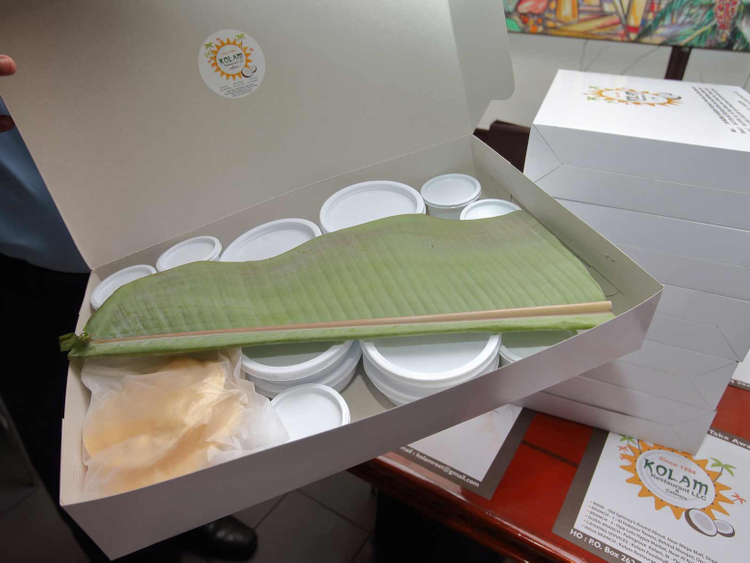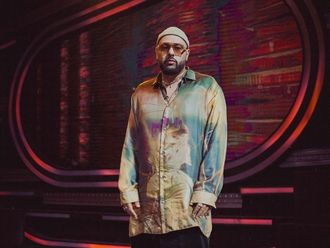Packed lunch
Since Onam is mainly a harvest festival, the onasadya is central to its celebrations. Preparing the feast, where anything from 20-64 items are served on a banana leaf, is a process that stretches over days. The womenfolk traditionally make pickles, savouries and sweets days in advance.
With hotels, restaurants and events organised by local Malayali associations now offering onasadyas, many people in Kerala and in the UAE choose to eat out during the festival. Those with hectic schedules simply get packaged onasadya instead of the full-fledged meal, from places such as Kerala Kitchen Restaurant in Dubai and Kolam Restaurant’s outlets in Dubai and Sharjah.
Others simply rush to the nearest supermarket — often at the last minute — to grab ready-made packets of crisps and bottled pickles. Several supermarkets and stores in the UAE sell packaged chopped vegetables required to prepare traditional dishes such as avial and sambar. Shops in Kerala even sell banana leaves made from paper to meet the spike in demand.
Some people insist on carrying on with tradition though. Advertising professional and Karama resident Vidya Manmohan, 38, says: “I have a huge family and we all gather in one house. While growing up in Sharjah, my mother and aunts would gather at our home and prepare the feast together.
“We now conduct a potluck where each member brings one dish. We then eat together the traditional way — on banana leaves. Once, I invited colleagues of varying nationalities and cultures from my workplace. They were fascinated by the feast and found it exotic.”
All white
Dressing up remains an integral part of Onam. Men wear white sarong-like mundus while the women don traditional kasavu saris and beautiful gold jewellery.
These used to be everyday clothes in Kerala years ago, but buying and wearing these ethnic garments is now reserved for special occasions and festivals.
Rijo Raphael, 32, is a project manager living in Abu Dhabi. He has lived in the UAE all his life, and says Onam is a time when friends dress up in traditional clothes and gather together in celebration of their roots.
“Having been brought up in Dubai, there aren’t too many traditional values that we keep up with. Onam is the primary one,” he says. Moreover, garment retailers have introduced new styles and designs for kasavu saris, in a bid to spruce up the traditional garb.
Flower power
A pookalam or floral carpet, usually created in the courtyard of a house, is significant during Onam. Children gather flowers from various gardens and the family together lays them out in intricate, colourful patterns.
Now, people prefer imported flowers. Schools and offices hold pookalam design contests, which can be very competitive.
In the UAE, Indian clubs and stores create pookalams during Onam. Some residents also create them at home — with modern themes. Raphael says, “As part of a basketball team, we made a pookalam last year — half traditional and half basketball — to honour the custom and the team.”
Tiger dance
Many years ago, women used to perform a folk dance called thiruvathirakali during Onam, retelling stories from the epics. But these days it is a rare sight in Kerala.
However, pulikali or tiger dance, another Onam staple, is still seen widely across the state. Male performers paint themselves yellow, red and black, like tigers, and dance to music from traditional percussion instruments. In the UAE, the dance form can be seen in stage shows organised by Indian clubs and associations as part of Onam celebrations. Many people see these as a chance to educate their children or friends about Keralite culture.
Growing up in the Nineties, Onam usually fell during the annual school holidays and offered me a chance to experience all of this in Kerala, playing games such as marbles and kabbadi, a traditional Indian outdoor sport. But these days, children mostly enjoy computer games.
Commercial invasion
In the past, shopping was minimal during Onam. However, the modern Malayali is a major consumer and the festival has now taken more commercial overtones.
Divas Sadasivan, a 34-year-old communications professional and former Dubai resident (who now lives in Kerala), says: “The essence of Onam for on-the-go Malayalis has become more about shopping. In the past, it was about celebrating together.”
With more and more international companies operating in Kerala, there is often very little time to enjoy the festival. In such cases, festivities are brought to the workplace. Team-building activities are followed by onasadya in the office. “Onam
is thus split between fun and frolic at the workplace and home,” says Divas.













